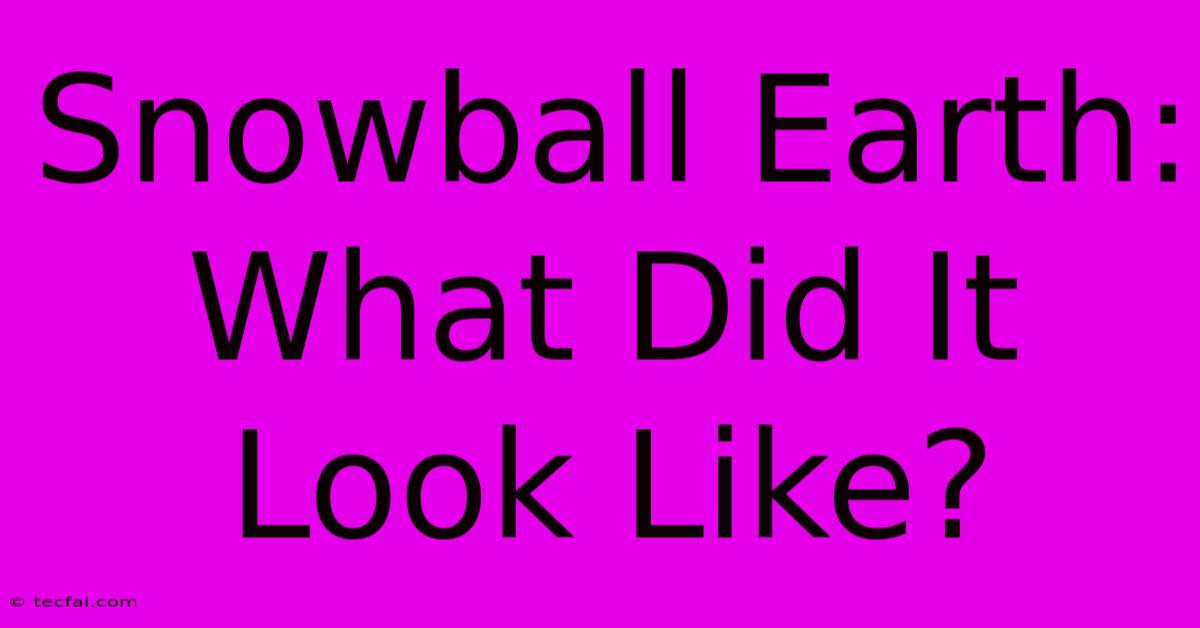Snowball Earth: What Did It Look Like?

Discover more detailed and exciting information on our website. Click the link below to start your adventure: Visit Best Website tecfai.com. Don't miss out!
Table of Contents
Snowball Earth: What Did It Look Like?
Imagine a world completely covered in ice. No lush forests, no vibrant oceans, just a vast, white expanse stretching as far as the eye can see. This is the scenario painted by the "Snowball Earth" hypothesis, a fascinating and controversial theory that proposes our planet was once entirely encased in ice, possibly more than once.
While the idea may seem like something out of a science fiction movie, evidence suggests it could have been a reality in Earth's ancient past. So, what exactly did Snowball Earth look like? Let's delve into this captivating period in Earth's history.
A World Frozen Solid:
The Snowball Earth hypothesis proposes that around 715 million years ago, during the Cryogenian period, Earth experienced a global glaciation event, transforming the planet into a frozen sphere. The ice sheets would have extended from the poles to the equator, covering even the warmest tropical regions.
What could have caused such an extreme freeze?
- Volcanic Eruptions: Massive volcanic eruptions could have released significant amounts of sulfur dioxide into the atmosphere. This sulfur dioxide would have reacted with water vapor to form sulfuric acid, creating a dense layer of aerosols that blocked sunlight.
- Continental Drift: The arrangement of continents could have affected ocean currents, potentially disrupting the global heat distribution system.
- Reduced Greenhouse Gases: A decrease in greenhouse gases like carbon dioxide could have reduced the planet's ability to retain heat.
Life in a Snowball World:
How could life have survived in such a harsh environment?
- Life Under the Ice: Some researchers believe that life could have persisted in pockets of liquid water beneath the ice sheets.
- Volcanic Activity: Volcanic activity may have provided heat sources that sustained life in some areas.
- The "Slushball Earth" Theory: Some scientists propose that the "Snowball" was not completely solid, but rather featured a "slushball" state with pockets of open water.
The Great Thaw:
The Snowball Earth event eventually ended, giving way to a period of rapid warming known as the "deglaciation event". This warming was likely caused by a combination of factors, including volcanic activity and the gradual release of greenhouse gases.
What evidence do we have for Snowball Earth?
- Glacial Deposits: Geologists have found evidence of glacial deposits at low latitudes, suggesting that ice sheets once covered the entire globe.
- Cap Carbonate Rocks: Unique rock formations called cap carbonates, which are found on top of glacial deposits, are thought to have formed as a result of a rapid release of carbon dioxide into the atmosphere during the deglaciation event.
A Controversial Theory:
The Snowball Earth hypothesis remains controversial, with some scientists questioning the extent of the glaciation and the viability of life during this period. However, the evidence continues to grow, and this fascinating theory continues to inspire researchers to explore the dramatic changes that Earth has undergone throughout its history.
While the details of Snowball Earth remain debated, the theory provides a glimpse into a world vastly different from our own, reminding us of the incredible resilience of life and the dynamic nature of our planet.

Thank you for visiting our website wich cover about Snowball Earth: What Did It Look Like?. We hope the information provided has been useful to you. Feel free to contact us if you have any questions or need further assistance. See you next time and dont miss to bookmark.
Featured Posts
-
Social Media Profit From Chores But Gender Roles Return
Nov 14, 2024
-
Branthwaite Absent From England Training Greece Up Next
Nov 14, 2024
-
Kusal Mendis Surpasses Jayasuriya In Sl Win
Nov 14, 2024
-
Travis Scott Coldplays Live Cover
Nov 14, 2024
-
Pete Hegseth From Anchor To Nominee
Nov 14, 2024
